Roundup of 2025’s Hottest Sax Gear So Far
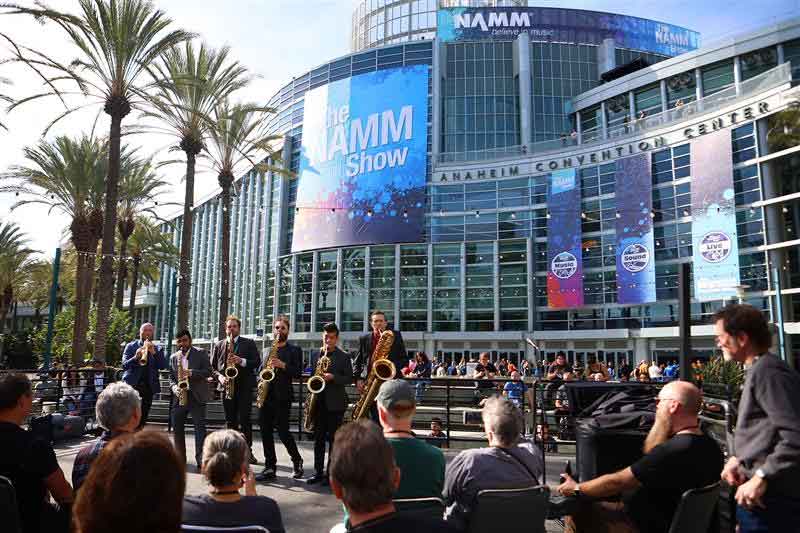
First, the Usual NAMM Mea Culpa…
Ok, so perhaps the title of this article obscures the fact that this is yet another, incredibly belated report from the ancient history that is NAMM 2025.
What seems to be the pattern for BSWE each January after NAMM is that there is just so much to share from the show that the roundup article has to be put together at the same time as we prepare other articles for the site. Otherwise, this effort becomes a bottleneck that prevents other content from being published.
Moving forward, we will work on a more efficient way of reporting on this but regardless..I strongly believe that what you’re about to read is still extremely relevant, timely, and offers plenty of fodder for fellow sax gear geeks to geek out on.
Introduction
NAMM 2025 was year filled with vendors, artists, hobbyists, and most importantly, music lovers. As always, my focus here is what’s new in the saxophone world. I was only able to attend two days this year but still had the chance to meet up with quite a few vendors and see if there was any new gear that really grabbed my attention, or older products that I may have overlooked over the years.
I will be covering the gear I had the chance to test play in the realm of saxophones, accessories, reeds, and mouthpieces. To those sax-related manufacturers and vendors I spoke with who may be reading this article, if your product was not included, it simply came down to time. That said, please feel free to reach out and I will be more than happy to learn more about your product and consider for further review.
The gear breakdown will be by brand and include: saxophones, mouthpieces, reeds, and accessories. Some gear I was not able to fully test play but will include because I think knowing what gear is out there and available helps players further refine there list when it comes to shopping on your budget.
Selmer
2025 Selmer Supreme Limited Editions (140 years of innovation)
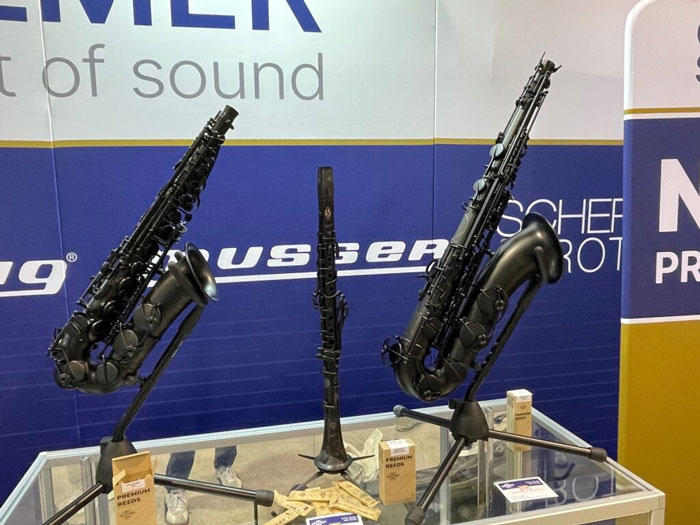
After the release of the Supreme and Signature Model tenor and alto saxophone, Selmer has just released a limited collector’s edition Supreme tenor and alto saxophone. The limited edition was released to commemorate the 140th anniversary of Henri Selmer Paris, with 1,000 mouthpieces, 800 saxophones, and 85 clarinets being released as tribute to its founding in 1885.
For saxophone specifically there will be 500 Selmer Supreme altos and 300 tenors. At NAMM this year, there was a limited edition Supreme tenor and alto, but they were only there for display so I was not able to play test. With that being said, the limited edition Selmer Supreme is the exact same horn as the standard Supreme but the engraving, aesthetic, accessories and limited run is what makes it unique.
Both alto and tenor come in a matte black finish with black key touches with the limited edition engraving really cutting through the finish. The limited edition also includes a special case, metal strap, concept mouthpiece, black matte chrome ligature and cap, black chrome end plug, and cleaning accessories.
According to Henri Selmer’s website as of January 2025, the Supreme collector alto is $10,814.46 USD and tenor $14,091.57 USD, compared to the standard Supreme brass finish price of $9,274.22 USD for alto and $11,906.83 USD for tenor.
If you are a collector or really like the matte black finish and accessories and you see the additional $1,500 USD to $2,100 USD as worth it, then I would recommend looking for a dealer that has one in stock. On the other hand, if you don’t care for the limited edition run but like the Supreme model, than I would recommend saving the additional $1,500 for alto to $2,100 for tenor, and putting that money towards lessons, mouthpiece, reeds, accessories, or even getting the Supreme you like professionally setup by your trusted repairman so that it really plays better than it did coming out of the factory.
Keilwerth
Keilwerth Saxophone 100 Anniversary Model
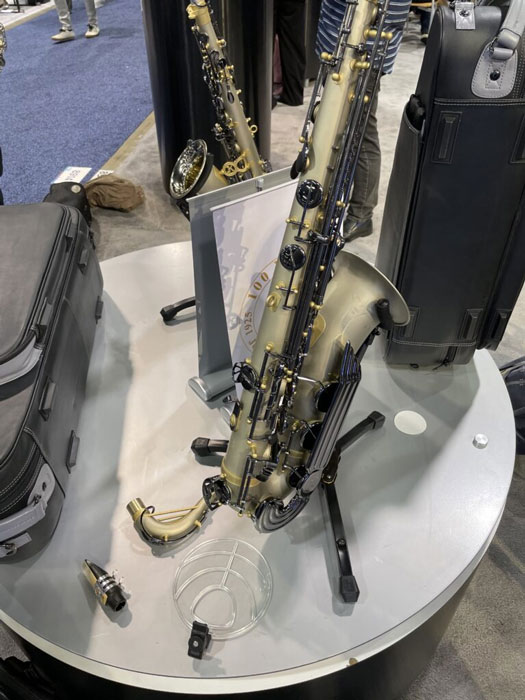
My first tenor saxophone was a Keilwerth EX 90 Series III which was an intermediate offering Keilwerth had at the time. Since then, Keilwerth has been producing the SX90R model for quite some time, and this year, they released the Keilwerth 100th Anniversary saxophone where they will be producing a limited run of 100 between alto and tenor.
The Keilwerth 100th Anniversary model is based off of the Shadow SX90R, with the metal being nickel silver vs traditional brass. In addition, as you can see from the finish, it is sand blasted with the gold and nickel silver being accented throughout.
One of the most notable features is the angel wing that covers the B, Bb, C#, and low C keys that was a feature seen on the vintage Tone King’s from the 1950’s. I was told by Al Maniscalco, Director of Sales & Marketing at Buffet Crampon USA, that the angel wing can be removed by the player depending on their preference.
The finish on the keys are a black nickel plated and there is ebony wood on the pearls and even thumb rest as opposed to the traditional oversized pearls. One of the notable features is the limited edition model comes with two necks – the traditional SX90R neck and a ICON neck which is a different taper and showcases the metal bar underneath for additional support.
When test playing the tenor with both necks, I overall really enjoyed the limited edition model with the ICON neck as I found the sound was more compact versus spread, and with this neck design it was easier to get around the entire range of the horn at various dynamic levels.
The final item I’ll mention is the limited edition case, which I believe is the product of Keilwerth working in conjunction with Gard Bags to produce.
When it comes to price, the Keilwerth 100th Anniversary model alto is retailing for $7,956 USD and the tenor at $8,709 USD but I have seen some prices where the list is higher. If you are a fan of Keilwerth and have played them for years, than I recommend checking out this 100th Anniversary limited run to see what you think. On the other hand, if you like Keilwerths but the limited edition price is not within your budget, I would either look for a used Shadow tenor or even a standard Keilwerth SX90R and play test it with the ICON neck which you can purchase separately as this setup will be significantly less expensive.
Ted Klum

It was great to see Ted Klum had a booth at NAMM this year as its been quite some time since I have had a chance to play test his new models. This year I test played a tenor FocusTone Tonamax HR, Florida Model Hard Rubber, and Florida Model Hard Rubber with the “Mark Turner” facing.
For those of you who have not tried Ted’s mouthpieces, I would have to say in terms of craftmanship, attention to detail, and quality control, Ted makes by far some of the best modern mouthpieces you can buy today. There were some alto models such as the newer X model which is inspired by a vintage HR Dukoff D8 and targeted towards players that want something brighter in the contemporary, smooth jazz, and R&B genres.
Unfortunately, there wasn’t enough time to try all of his models, but I will say I really enjoyed the Tonamax and Florida model.
Ted let me try each of these mouthpieces in the traditional hard rubber as well as marbled finish. In addition, he did have 7 tip openings. In the past I tried a 7*, which played great, but I think the 7 tip opening is the facing for me.
The Florida Model hard rubber with the Mark Turner facing was probably one of the easiest mouthpieces to play in the altissimo at various dynamic levels and with a full sound without any pinching. I found all models were very comfortable but feel those players who want something a bit brighter and more focused will enjoy the Florida model, and those players that want something that reminds them of a reso chamber or slant or something darker will enjoy the Tonamax.
Overall, it was hard to choose which one I liked most because they all played great, but in terms of overall color, control, comfort, and sound, I am definitely going to revisit the Tonamax 7 tip opening in traditional hard rubber, as it had various colors and aspects I have not found on my vintage slant Otto Link.
Vandoren

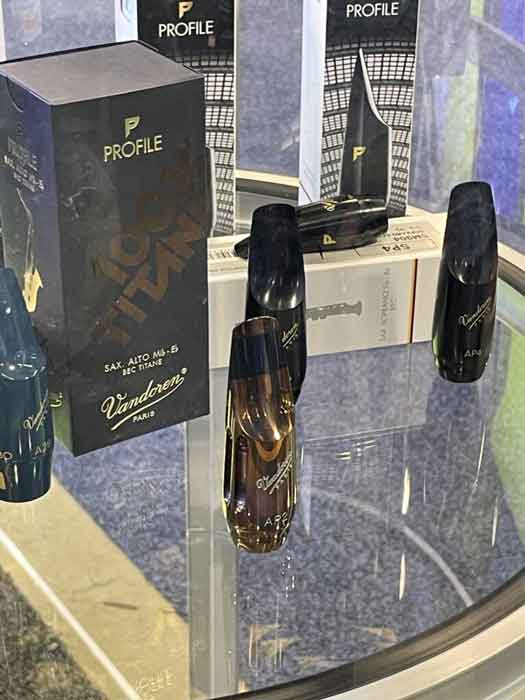
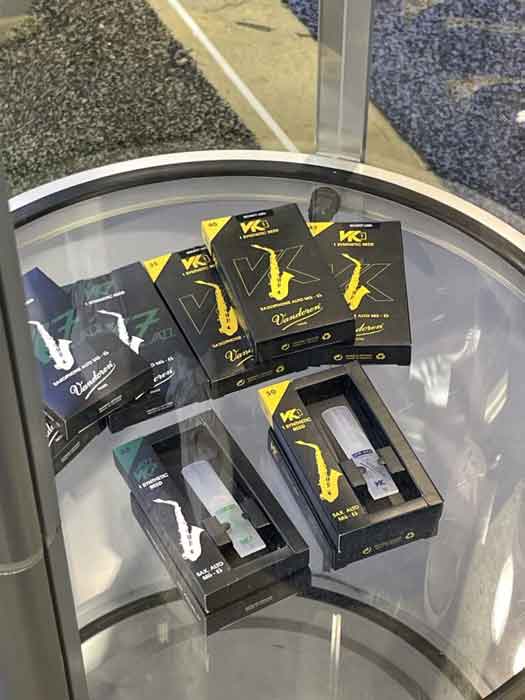
At the Vandoren booth this year, I was able to meet up with Michael Fenoglio, Vice president of Marketing, who was nice enough to share with me a few new products that were recently released or will be coming to market soon. Some of those products were the metal V16 soprano mouthpiece, the VK7 which is Vandoren Jazz’s synthetic reed for alto saxophone, and the Profile family of classical saxophone mouthpieces. But one product that stuck out to me was the Vandoren AP2, which is a classical mouthpiece completely made out of titanium, and going to be a limited edition run.
Unfortunately, I was not able to play test any of these products at the booth but the one that most interested me was the Vandoren VK7 Jazz synthetic reed. Looking at a reed comparison chart, the VK7 range is from 10 to 35 which generally translates to a 2 Java Red (10 VK7) to a 3 Java Red (35 VK7). I believe the VK7 Jazz synthetic reed retails for around $40 dollars a reed so would be interested to try one to see how it compares to the other traditional cane cuts and whether its benefits justify the cost.
BetterSax
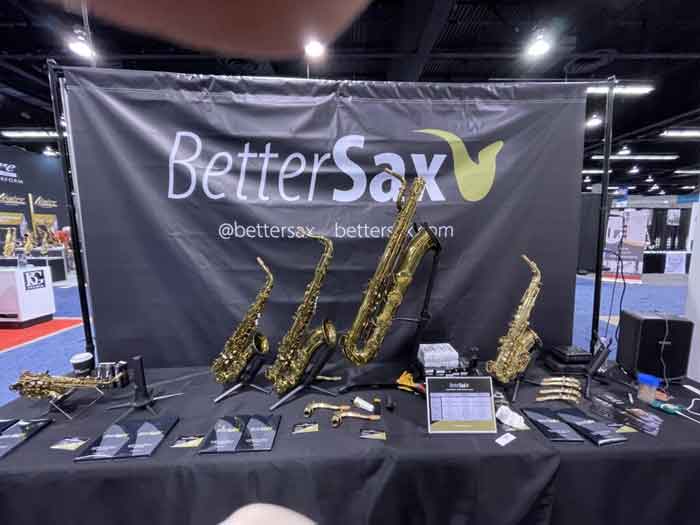
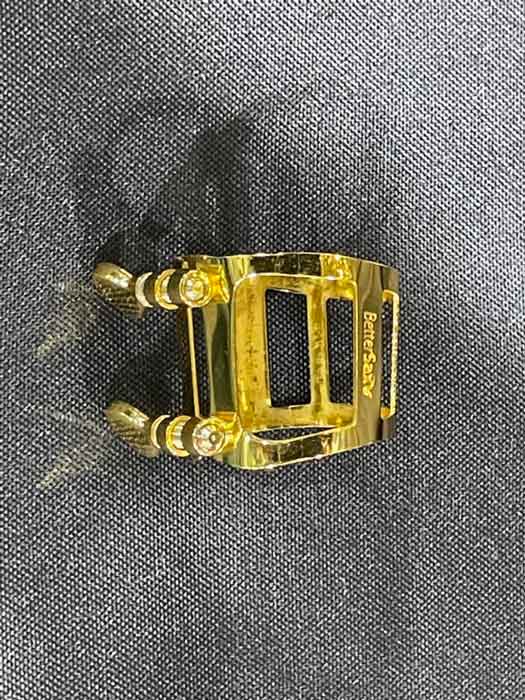
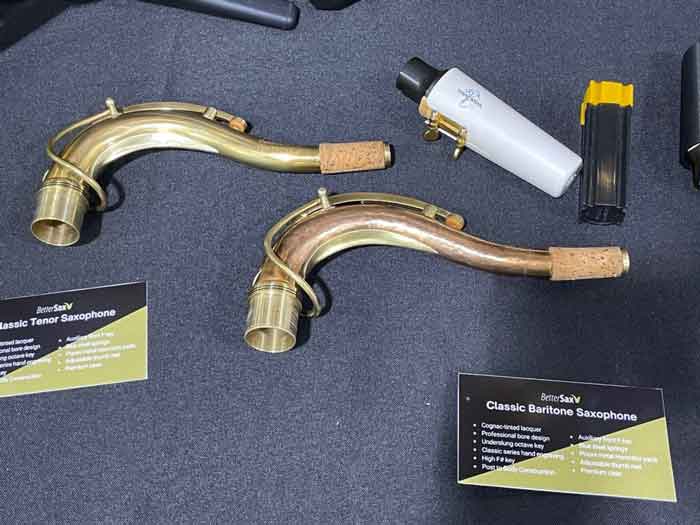
I saw Jay MetCalf at last years NAMM show but this year Jay was an exhibitor showcasing his BetterSax line of saxophones, mouthpieces, reeds, ligatures, etc. I was able to play test the BetterSax Classic alto and tenor saxophones.
Overall, I was quite impressed with these horns as they are targeted towards beginners or those players who may want a backup saxophone that does not break the bank. As of January 2025, the BetterSax Classic alto I retails for $799 and the BetterSax Classic tenor retails for $1,499.
In addition to the BetterSax saxophones, Jay did have an assortment of KB necks from the Redwood to Canyon models. Each offered its own resistance levels. I found the Canyon to be more spread in comparison to the Redwood, which was more focused. My preference was the BetterSax Classic tenor paired with the KB Redwood neck due to the resistance level and overall playability across the entire range of the horn.
In addition to the necks and saxophones, I was able to try the BetterSax Classic mouthpieces and the BetterSax Burnin mouthpiece. The BetterSax Classic mouthpiece comes with the purchase of each BetterSax Classic saxophone but you can also buy the mouthpiece separately. The BetterSax Classic mouthpieces for tenor or alto are aimed at being an alternative to the traditional Yamaha 4c student mouthpiece.
Each BetterSax Classic for alto and tenor played well from top to bottom and was quite easy to control. Sonically, the BetterSax Classic mouthpieces reminded me of a cross between a Selmer C* and the Yamaha 4c.
Overall, I think they are a great mouthpiece to start with as they are made in USA and hand-finished at the end of the manufacturing process. As of January 2025, the BetterSax Classic mouthpieces retail for between $39.99 to $49.99, so for its price point, its a good mouthpiece to get started on.
Now in comparison, I was able to try the BetterSax Burnin tenor mouthpiece with a 7* tip opening. I enjoyed this mouthpiece overall as it was free-blowing, easy to articulate with, and had a dark overall sound, particularly in the bottom range, but when pushed, you hear the brights, especially in the upperstack. The BetterSax Burnin mouthpiece is manufactured by JodyJazz and features a rollover baffle, large chamber versus medium chamber, and straight sidewalls.
The next few items at the BetterSax booth that I didn’t have a chance to try but were new releases were the BetterSax Classic soprano, which will be coming out soon as well as the BetterSax Classic Baritone, which will complete the BetterSax saxophone lineup from soprano to baritone sax.
The final few items at the booth were the BetterSax reeds, BetterSax Session Alto which is the next upgrade up from the BetterSax classic, and finally the Better Sax ligature which is currently a prototype.
The BetterSax Session Alto is targeted more towards the advancing and professional saxophonist, with additional features and upgrades but still at an intermediate price point of around $2,400. I did not have a chance to fully play test the Session and compare it to the Classic but will try to do so in the future.
I was able to try the BetterSax Jazz Cut reeds in a 2.5 for tenor. I am still in the process of finding out more information regarding the cut to see how this compares to Boston Sax Shop, Vandoren, D’Addario, Marca, Rigotti, Ishimori, Roberto’s, etc, but I do know that the cane for the BetterSax reeds comes from Marca. Overall, the BetterSax reed I tried played well and I noticed more of the brights in my sound compared to other reed cuts and brands which I find to be darker.
Finally, we come to the BetterSax ligature. At the time of this writing, this is a prototype and is made by Peter Jessen who is based out of Denmark and has his own line of ligatures which can be found in the states at Kim Bock’s or SK Mouthpieces. Funny enough, the BetterSax ligature was one of my favorite pieces of gear at NAMM this year. It’s similar to a two-screw vintage Selmer ligature, but the brass is thicker and designed a bit differently, but what I noticed was how simple it was to put on and I liked the overall response. This ligature allowed the reed to vibrate, was easy to adjust, and sturdy enough that it would not bend like traditional brass ligatures.
I want to thank Jay and the BetterSax team for taking the time to show me there line-up of products. A further in-depth review will be coming out later this year.
JodyJazz
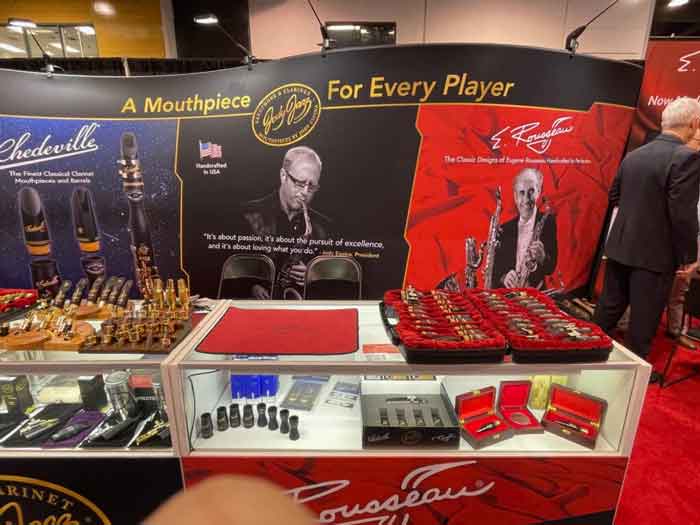
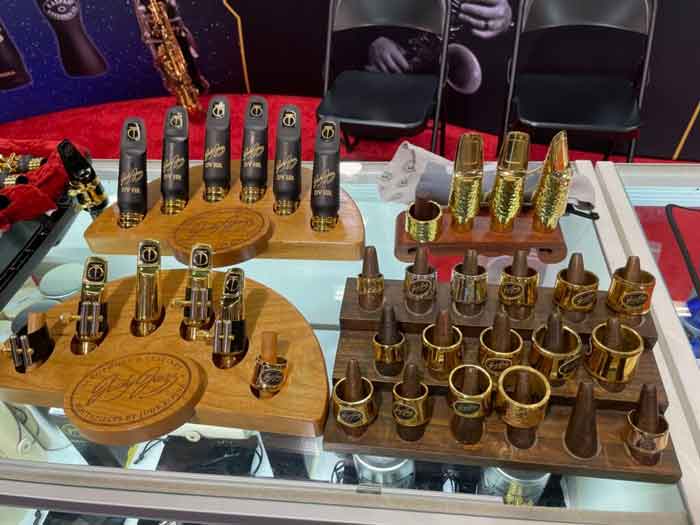
On my last day at NAMM, I stopped by the JodyJazz booth to see what was new and this year. Jody introduced the DV JC (Jody Custom) alto metal mouthpiece.
Although there was not enough time for me to sit down and try it, Colin Schofield, VP of Sales and Marketing was nice enough to share with me more about this particular piece. Colin told me that over the years, Jody had been tweaking his original DV metal mouthpiece in an effort to make it easier for him to play across a wider array of musical genres. He added that with these modifications, the DV JC sits in-between the DV and DV NY with the alto version being available now and work being done to release a tenor version later in 2025. I like both the DV and DV NY, but overall, I like the DV NY as I find it leans more on the darker side versus the DV, which, to me can be a bit bright depending on your setup.
With that being said, I hope to try the DV JC (especially for tenor) later this year which sits between the DV and DV NY and might be what an increasing number of players have been looking for.
Silverstein
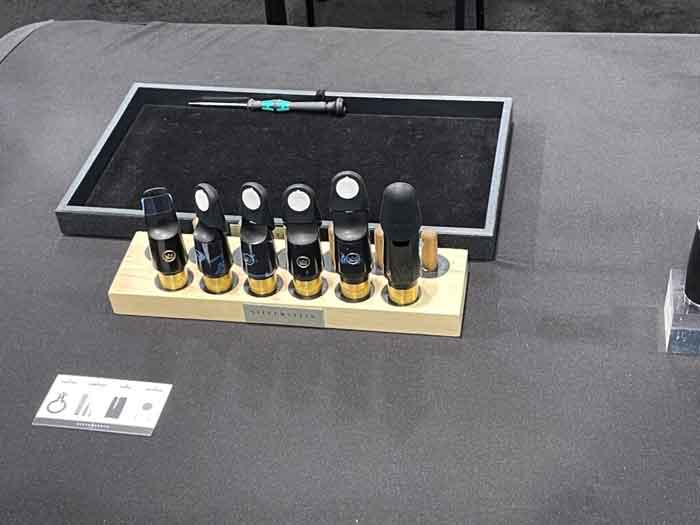
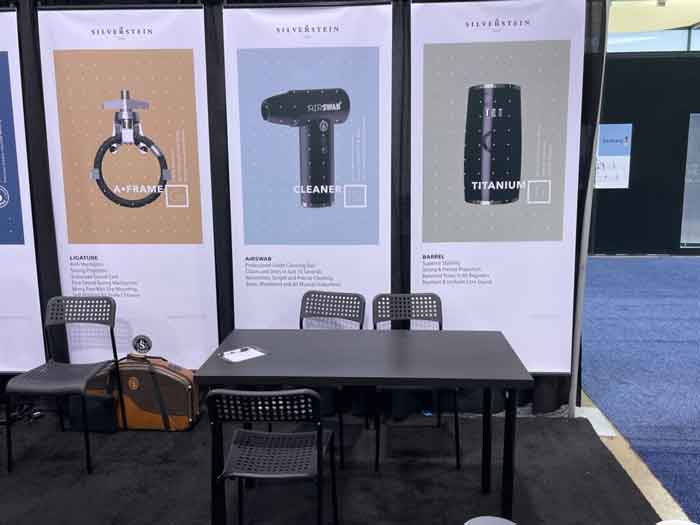
There was quite an array of products at the Silverstein booth this year. The Airswab for cleaning your saxophone and Titanium barrel for clarinet, I believe, were some of the newer products Silverstein was showcasing in addition to updates to their synthetic Alta reed.
With that being said, I actually took some time to play test the “Leo” mouthpiece for tenor saxophone. I know Silverstein is known mainly for their ligatures but I wanted to see how the Leo performed. I tried the 7 tip opening and when I spoke with Jim Mayr, Key Account Manager at Silverstein, he told me that the Leo has a medium chamber and is most reminiscent of the vintage Meyers for tenor. Since I used to own and play a vintage Meyer NY for tenor I understood what he was talking about.
The Leo mouthpieces are made out of German hard rubber and is individually play tested and hand-finished, but I was not able to locate the name of the refacer who does the finishing work. I was pleasantly surprised when playing the Silverstein Leo tenor mouthpiece by its consistency and fluidity from top to bottom, and it’s probably one of the more sonically even mouthpieces from low to medium to high that I have played in a while.
Compared to a vintage Otto link hard rubber or some other hard rubber models with a medium chamber, I did not find the Leo had the same edge or tonal timbres in the upper and lower stack, and had a more neutral and warm sound.
In terms of projection, I found the sound to be a bit more spread than focused with minimal back-pressure, making for quite a free blowing feel. The Leo’s playability and intonation took no time to adjust to. I would say that if you enjoy playing on Meyer hard rubber mouthpieces for tenor (specifically the vintage NY’s), I think you are going to really enjoy the Silverstein Leo.
Rovner LGX Ligature

I had a chance the try the LGX ligature at last years NAMM show when it was just a prototype. This year, I tested the Rovner LGX ligature as its now in production to see how it compared to the Versa X & Eddie Daniels, which I have used on alto for quite some time.
The Rovner LGX ligature has a metal plate that reminds me of the Versa X, but the LGX plate appears to be thinner, with an overall different design and without the flap covering option seen on the Versa X. In addition, the two metal bars on the LGX remind me of the Rovner Platinum ligature, as these metal bars are thicker and slightly heavier, which allows for more vibration from the reed.
The Rovner LGX ligature worked well with my setup and was easy to adjust. I found when really pushing a lot of air through my mouthpiece, the LGX allowed the air to flow freely without dampening or restricting the sound. The overall response was great from top to bottom, which I think can be attributed to the heavier bars and new plate design enabling the aforementioned enhanced reed vibration. If you want to learn more about the Rovner LGX ligature click here.
BG France Ligatures, Neckstraps, & Accessories



This year I stopped by the BG booth as I saw quite a few players using the Zen Leather Strap and Zen Yoke Strap which come in white, black, and red leather.
Actually, my first upgraded neck strap when I started playing the saxophone was the original BG Yoke Strap, but the Zen Yoke Strap showcases an updated hook, metal adjustment bar, and further cushioning – all of which make for a great improvement in the strap overall.
At the booth, I met Jimmy Merchant who is an operations Manager for BG France and he was nice enough to let me try the line of BG ligatures for tenor.
I went back and forth specifically with the DUO ligature in the silver-plated, gold-plated, and black-lacquered finish. I liked how the DUO ligature in the black lacquered finish responded as well as its sonic clarity in comparison to the other finishes, but the differences to me were very minimal.
If you are looking for a wider cushion, than I would recommend the Zen Yoke Strap, but if you are looking for a traditional leather strap, than you may prefer the Zen Leather Strap.
Due to my own particular physiology, the SaxHolder product is what works best. However, in terms of the more traditional neck straps I’ve played on in the past, the BG straps are definitely products to check out.
Honorable Mentions
- Theo Wanne Essential Mouthpieces
- Trevor James prototype necks & EVO saxophones
- Forestone Saxophones & Reeds
Final Thoughts
It is always fun attending NAMM to see what new gear is out there and touching base with various manufacturers and friends. I will say this year’s attendance across artists, guests, and exhibitors seemed to be better, but I did still notice in various parts of the show empty booth space which I think can still be attributed to lower turnout in the past as well as high exhibitor booth prices.
For the past few years, it’s seemed as though the number of international and boutique brands in attendance has decreased and a greater percentage of the brands were either bigger, or nearer in proximity to Anaheim.
I still find value attending the show and would recommend attending NAMM at least once to can get an idea of what the show is all about.
Unfortunately, as is always the case, I was not able to visit every booth and play test every product that I would have liked to. I want to thank all those exhibitors who took the time to meet with me and share what’s new in terms of products as well as their business as a whole. I am looking forward to reviewing some of this gear in more detail in the near future and hope to see everyone at NAMM 2026!


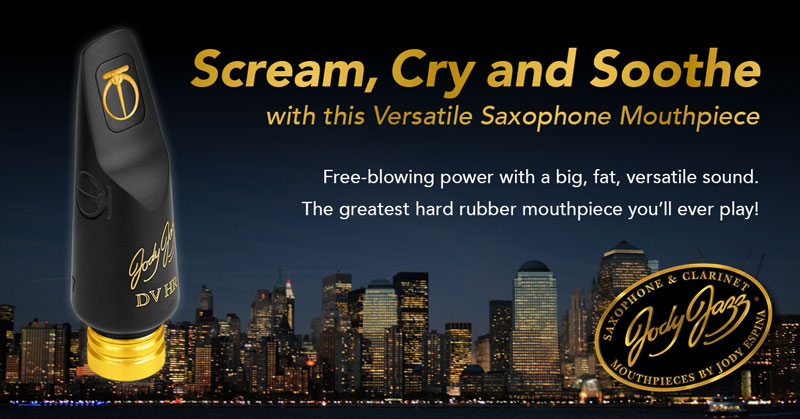



April 29, 2025 @ 7:12 am
Hello Zach,
Just a quick note to say as a fellow saxophonist, I really enjoy your website and shared knowledge of the saxophone world.
Thanks for sharing and will be checking for future updates. 🎷😊
Sincerely,
Gary Calabrese
May 2, 2025 @ 2:57 pm
Hey Gary,
Glad to hear you enjoyed the article. Just trying to share to the best of my knowledge what is out on the market that I have been able to check out. There is so much gear available today than there was in the past so figuring out what is out there tied to your budget will make it easier to stay on your current setup or potentially find a piece a gear that you prefer that gets you back into the shed and practicing (that’s my goal for myself)
May 3, 2025 @ 4:04 am
Thanks Zach,
You certainly do know what’s going on in the saxophone world.
Appreciate your sharing. Some are quite tight lipped about sharing anything.
🎷
BetterSax Gear - Is It Actually Better? » Best. Saxophone. Website. Ever.
August 4, 2025 @ 7:36 pm
[…] trying the BetterSax Classic tenor at NAMM 2025, it has been great to be able to sit down and really take a closer look at its overall construction […]